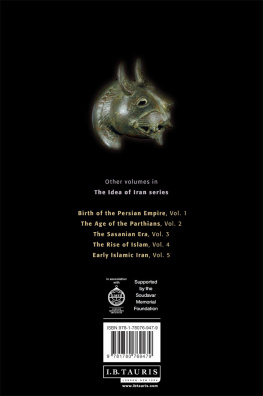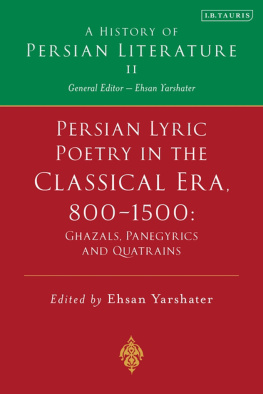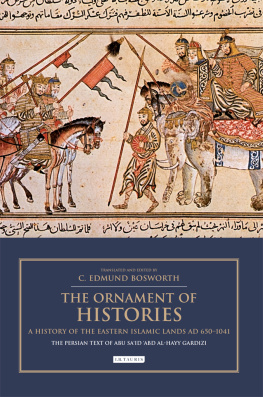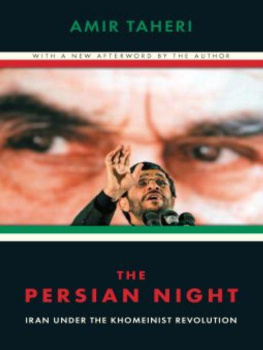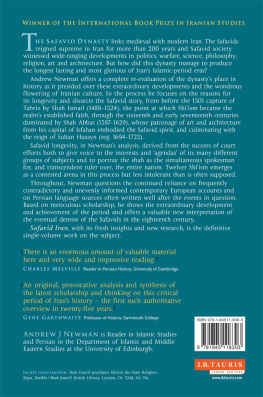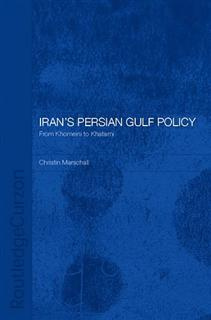Edmund Herzig is The Masoumeh and Fereydoon Soudavar Chair of Persian Studies, Faculty of Oriental Studies, and a Fellow of Wadham College at the University of Oxford. He is the co-editor of The Armenians: A Handbook and Iran and the World in the Safavid Age (I.B.Tauris).
Sarah Stewart is Lecturer in Zoroastrianism in the Department of the Study of Religions at SOAS, University of London. She is the co-editor, with Vesta Curtis, of Birth of the Persian Empire, The Age of the Parthians, The Sasanian Era and The Rise of Islam; and, with Edmund Herzig, of Early Islamic Iran all published by I.B.Tauris. In addition she edited The Everlasting Flame: Zoroastrianism in History and Imagination, published by I.B.Tauris in 2013.
The Age of the Seljuqs
This volume is dedicated to
Gherardo Gnoli
(19372012)
Already available in The Idea of Iran series
Birth of the Persian Empire, Vol.1
Edited by Vesta Sarkhosh Curtis (British Museum) and Sarah Stewart (SOAS, London).
ISBN: 978-1-84511-062-5
The Age of the Parthians, Vol. 2
Edited by Vesta Sarkhosh Curtis (British Museum) and Sarah Stewart (SOAS, London).
ISBN: 978-1-84511-406-0
The Sasanian Era, Vol. 3
Edited by Vesta Sarkhosh Curtis (British Museum) and Sarah Stewart (SOAS, London).
ISBN: 978-1-84511-690-3
The Rise of Islam, Vol. 4
Edited by Vesta Sarkhosh Curtis (British Museum) and Sarah Stewart (SOAS, London).
ISBN: 978-1-84511-691-0
Early Islamic Iran, Vol. 5
Edited by Edmund Herzig (University of Oxford) and Sarah Stewart (SOAS, London).
ISBN: 978-1-78076-061-2
Published in 2015 by I.B.Tauris & Co Ltd
6 Salem Road, London W2 4BU
175 Fifth Avenue, New York NY 10010
www.ibtauris.com
Distributed in the United States and Canada Exclusively
by Palgrave Macmillan
175 Fifth Avenue, New York NY 10010
Copyright London Middle East Institute, 2015
The right of Edmund Herzig & Sarah Stewart to be identified as the editors of this work has been asserted by them in accordance with the Copyright, Designs and Patents Act 1988.
All rights reserved. Except for brief quotations in a review, this book, or any part thereof, may not be reproduced, stored in or introduced into a retrieval system, or transmitted, in any form or by any means, electronic, mechanical, photocopying, recording or otherwise, without the prior written permission of the publisher.
References to websites (URLs) were accurate at the time of writing.
Every attempt has been made to gain permission for the use of the images in this book. Any omissions will be rectified in future editions.
The Idea of Iran Vol. 6
ISBN 978 1 78076 947 9
eISBN 978 0 85773 811 0
A full CIP record for this book is available from the British Library
A full CIP record is available from the Library of Congress
Library of Congress Catalogue Card Number: available
Illustrations
Isfahan in the eleventh and twelfth centuries (modified from Durand-Gudy, Iranian Elites).
Access to Isfahan.
Royal pastures in the province of Isfahan.
Nizm al-Mulks network.
Typology of relations between actors of the imperial and local political fields.
Typology of relations.
Typology of relations.
Constructions in Baghdad during the Seljuq period. Map by V. Van Renterghem (after Le Strange, Baghdad).
Local and foreign fiqh teachers in Baghdad during the Seljuq period, according to the madhhab.
Genealogical tree of the Dmaghn family in Baghdad during the Seljuq period (from biographical sources).
Isfahan, Friday Mosque, three-dimensional drawing (after Hillenbrand, Islamic Architecture).
Plan of mosque (photogrammetric view; after Laleh).
Reconstruction of how the south dome chamber was inserted into the earlier mosque (after Galdieri, Isfahan).
Axonometric view of south dome chamber (after Galdieri, Isfahan).
Exterior view of south dome.
Interior elevation of south dome chamber (after Laleh).
Squinch of south dome chamber (after Pope and Ackerman, Survey).
Exterior view of north dome (after Ettinghausen and Grabar).
Interior elevation of north dome chamber (after Seherr-Thoss).
Section of north dome chamber (after Schroeder, Survey, pl. 289).
Lower walls of south dome chamber (after Pope and Ackerman, Survey).
Plan of north dome (photogrammetric view; after Laleh).
Plan of north dome (photogrammetric view; after Laleh)
Decorative details of the exterior south and east sides of the north dome chamber (after Galdieri, Isfahan).
Underside of the north dome (after Seherr-Thoss).
Acknowledgements
The editors remain indebted to the Soudavar Memorial Foundation for supporting The Idea of Iran symposia and published proceedings. Special thanks are due to Mrs Soudavar-Farmanfarmaian for the interest that she takes in the publication series and her invaluable advice and support.
This volume combines the contributions of speakers from two symposia (2011 and 2012) and would not have been possible without the dedicated skill, not to mention the patience, of Dr Parvis Fozooni in formatting and typesetting the papers. We also thank Charles Peyton for the time he devoted to copy-editing and also Thomas Munt for his help with the transliteration of Arabic and Persian words. We are grateful to Louise Hosking, at the LMEI, who has liaised with authors and always been willing to proof read.
We would like to thank Iradj Bagherzade, Alex Wright and the staff at I.B.Tauris for their help in producing the publication.
Finally, our thanks go to the authors for their excellent contributions.
Foreword
Edmund Herzig
T he chapters brought together in this volume were first presented as conference papers at two symposia in the Idea of Iran series, held in the School of Oriental and African Studies in London in 2011 and 2012. All of them deal, in one way or another, with the question of the Turks and Iran. If we include in our understanding of the Iranian world all the territories whose inhabitants spoke an Iranian language, including Bactrian, Khwarezmian, Sogdian, Tokharian and others, then Turks have been an important and growing presence in that world since the most ancient times. Even if we restrict ourselves to the territories of the Sasanian Empire, during the latter years of that empire Turks were an important presence in the eastern frontier provinces of Sogdia and Tokharestan, where Turkish rulers were among the strongest adversaries of the advancing Arab-Muslim armies in the seventh and eighth centuries.
During the Islamic era, Turks entered the Dr al-Islm, and especially Transoxiana and Iran, in a variety of ways. From early on, Muslim sources express admiration for the martial qualities of the Turks, and they were in high demand as slave soldiers (ghulm, mamlk) at the caliphal court in Baghdad and in the armies of provincial emirs, including those of the independent Iranian dynasties of Khorasan, Sistan and Transoxiana. Slaves were acquired through capture on campaign and through trade the Samanids being heavily involved in the trade in Turkish slaves from the lands to the north and east of their realm. Only non-Muslims could be enslaved, however, and as more of the Turks of the steppe lands beyond the Samanid borders converted to Islam (a process that is also particularly associated with the Samanid ninth and tenth centuries), so increasing numbers of Turks entered Transoxiana as free men, some invited in by local rulers as
Next page
